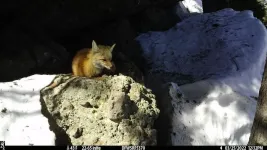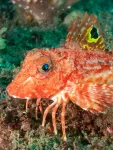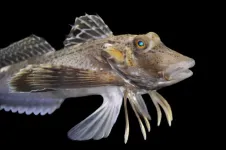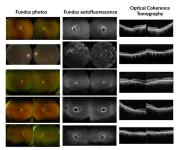(Press-News.org) A rescue effort can take many forms – a life raft, a firehose, an airlift. For animals whose populations are in decline from inbreeding, genetics itself can be a lifesaver.
Genomic research led by the University of California, Davis, reveals clues about montane red foxes’ distant past that may prove critical to their future survival. The study, published in the journal Molecular Biology and Evolution, examines the potential for genetic rescue to help restore populations of these mountain-dwelling red foxes. The research is especially relevant for the estimated 30 or fewer native red foxes living in the Lassen Peak region of California.
The study found that inbreeding is impacting the Lassen red fox population. Thousands of years ago – long before unregulated trapping and poison knocked back their populations in the 1890s and early 1900s—red foxes were not only abundant in these mountains, they were also more connected to neighboring foxes in Oregon, the Rocky Mountains and Washington Cascades than they are today. This positions them well for genetic rescue should managers decide to pursue it and reconnect the populations.
“Nothing we found disqualifies red foxes from genetic rescue,” said lead author Cate Quinn, who conducted the research as a UC Davis postdoctoral researcher with the Mammalian Ecology and Conservation Unit within the School of Veterinary Medicine. She is now a research biologist with the USDA Forest Service Rocky Mountain Research Station. “The study suggests that genetic rescue could be a viable option for the Lassen population.”
Rescue workers
Genetic rescue is a conservation tool to reverse the effects of inbreeding depression, which is when inbreeding reduces an animal’s fitness and ability to reproduce. Genetic rescue involves bringing new individuals to a population to introduce genetic variation and spur growth.
The tool is not considered lightly, and managers first must understand the severity of inbreeding, the historical baseline genetic rescue seeks to restore, and the deeper evolutionary relationships the foxes share with each other.
To fill those knowledge gaps, the scientists sequenced 28 whole genomes from the four subspecies of montane red foxes. These include small, isolated populations in the Pacific mountains, Oregon Cascades, Lassen Cascades and the Sierra Nevada, as well as a larger population in the Rocky Mountains and a subspecies in the Sacramento Valley. Using genomic technology, the authors could peer back in time to see if a population was always isolated, to what extent, and when that began to change.
Abundant, connected and diverse
The study found high levels of recent inbreeding in Lassen and Sierra Nevada red fox populations, with the Lassen red foxes a high priority for intervention. Only one montane red fox is known to have entered the Lassen population in more than 20 years of monitoring, the study said.
The data also revealed that 10,000 to 12,000 years ago, montane red foxes in the Western United States were abundant, connected and genetically diverse. The Lassen population was likely connected to the Oregon red foxes within the last century, breaking from each other relatively recently, Quinn said.
A hopeful way forward
Combined, these findings point to a hopeful way forward for Lassen’s red foxes, and for other red foxes facing similar challenges.
“We think trapping drove their population down, but we didn’t know what was keeping them small,” said senior author Ben Sacks, director of the Mammalian and Ecology Conservation Unit at the UC Davis School of Veterinary Medicine. “Now we see that what kept them small appears to be inbreeding depression. If what drove their decline is gone, can we bring them back? There is hope here.”
Quinn agrees: “Not too long ago, this was an abundant, connected, diverse population. That diversity still exists. If we were to restore them as a group, these foxes may still have a lot of adaptive potential.”
She cautions, however, that true genetic “rescue” requires reconnecting the whole subspecies — not just growing one population.
“If we only consider each small pocket individually, they’re in trouble, but if we look at the whole montane system, restoration is still possible,” Quinn said.
Additional coauthors include Sophie Preckler-Quisquater of UC Davis and Michael Buchalski of the California Department of Fish and Wildlife.
The study was funded by the U.S. Fish and Wildlife Service, California Department of Fish and Wildlife, and UC Davis.
END
Genetic rescue for rare red foxes?
Genomic research uncovers options to restore Lassen red fox population
2024-09-26
ELSE PRESS RELEASES FROM THIS DATE:
Extreme heat impacts daily routines and travel patterns, study finds
2024-09-26
A groundbreaking new study conducted by a team of researchers from Arizona State University, University of Washington and the University of Texas at Austin reveals that extreme heat significantly alters how people go about their daily lives, influencing everything from time spent at home to transportation choices. The study, titled "Understanding How Extreme Heat Impacts Human Activity-Mobility and Time Use Patterns," was recently published in Transportation Research Part D and underscores the urgent need for policy action ...
ReadCube expands literature management with new AI Assistant and comprehensive search
2024-09-26
Digital Science announces ReadCube Pro, an AI-powered expansion of ReadCube, offering researchers new tools to simplify and accelerate literature management and literature monitoring workflows.
The new AI Assistant and Literature Monitoring in ReadCube – an award-winning leader in literature management and full-text document delivery – transform the way research teams access, organize, review and monitor scholarly literature by providing them with enhanced search capabilities while helping to significantly reduce time spent ...
New mutation linked to early-onset Parkinsonism
2024-09-26
Leuven, 26 September 2024 – A team of scientists led by Prof. Patrik Verstreken (VIB-KU Leuven) has identified a new genetic mutation that may cause a form of early-onset Parkinsonism. The mutation, located in a gene called SGIP1, was discovered in an Arab family with a history of Parkinson's symptoms that began at a young age. The study reveals that this mutation affects how brain cells communicate, providing new insights into the disease's development and potential treatment strategies.
A genetic clue to Parkinsonism
Parkinsonism is a group of neurological disorders that share similar symptoms, including motor dysfunction ...
Bacteria involved in gum disease linked to increased risk of head and neck cancer
2024-09-26
More than a dozen bacterial species among the hundreds that live in people’s mouths have been linked to a collective 50% increased chance of developing head and neck squamous cell carcinoma (HNSCC), a new study shows. Some of these microbes had previously been shown to contribute to periodontal disease, serious gum infections that can eat away at the jawbone and the soft tissues that surround teeth.
Experts have long observed that those with poor oral health are statistically more vulnerable than those with healthier ...
These fish use legs to taste the seafloor
2024-09-26
Sea robins are unusual animals with the body of a fish, wings of a bird, and walking legs of a crab. Now, researchers show that the legs of the sea robin aren’t just used for walking. In fact, they are bona fide sensory organs used to find buried prey while digging. This work appears in two studies published in the Cell Press journal Current Biology on September 26.
“This is a fish that grew legs using the same genes that contribute to the development of our limbs and then repurposed these legs to find ...
This fish has legs
2024-09-26
Sea robins are ocean fish particularly suited to their bottom-dwelling lifestyle: Six leg-like appendages make them so adept at scurrying, digging, and finding prey that other fish tend to hang out with them and pilfer their spoils.
A chance encounter in 2019 with these strange, legged fish at Cape Cod’s Marine Biological Laboratory was enough to inspire Corey Allard to want to study them.
“We saw they had some sea robins in a tank, and they showed them to us, because they know we like weird animals,” said Allard, a ...
Climate change: Heat, drought, and fire risk increasing in South America
2024-09-26
The number of days per year that are simultaneously extremely hot, dry, and have a high fire risk have as much as tripled since 1970 in some parts of South America. The results are published in a study in Communications Earth & Environment.
South America is warming at a similar rate to the global average. However, some regions of the subcontinent are more at risk of the co-occurrence of multiple climate extremes. These compound extremes can have amplified impacts on ecosystems, economy, and human health.
Raúl Cordero and colleagues calculated the number of days per year that each approximately 30 by 30 km grid ...
Rates of sudden unexpected infant death before and during the pandemic
2024-09-26
About The Study: This cross-sectional study found increased rates of both sudden unexpected infant death (SUID) and sudden infant death syndrome (SIDS) during the COVID-19 pandemic, with a significant shift in epidemiology from the pre-pandemic period noted in June to December 2021. These findings support the hypothesis that off-season resurgences in endemic infectious pathogens may be associated with SUID rates, with respiratory syncytial virus (RSV) rates in the U.S. closely approximating this shift. Further investigation into the role ...
Estimation of tax benefit of nonprofit hospitals
2024-09-26
About The Study: This study highlights the wide variation of nonprofit hospitals’ tax benefit across states, its high concentration among a small number of hospitals, and the primary role played by state and local taxes. Policy efforts to strengthen nonprofit hospitals’ taxpayer accountability are likely to be more effective when pursued at the local level.
Corresponding Author: To contact the corresponding author, Ge Bai, PhD, CPA, email gbai@jhu.edu.
To access the embargoed study: Visit our For The Media ...
Scientists discover gene responsible for rare, inherited eye disease
2024-09-26
Scientists at the National Institutes of Health (NIH) and their colleagues have identified a gene responsible for some inherited retinal diseases (IRDs), which are a group of disorders that damage the eye’s light-sensing retina and threatens vision. Though IRDs affect more than 2 million people worldwide, each individual disease is rare, complicating efforts to identify enough people to study and conduct clinical trials to develop treatment. The study’s findings published today in JAMA Ophthalmology.
In a small study of six unrelated participants, researchers linked the gene UBAP1L to different forms of ...
LAST 30 PRESS RELEASES:
Orthopedics can play critical role in identifying intimate partner violence
Worms as particle sweepers
Second spider-parasitic mite described in Brazil
January 2026 issues of APA journals feature new research on autism, pediatric anxiety, psychedelic therapy, suicide prevention and more
Private equity acquired more than 500 autism centers over the past decade, new study shows
New cervical cancer screening guidelines from the US Department of Health and Human Services
Estimated burden of COVID-19 illnesses, medical visits, hospitalizations, and deaths in the US from October 2022 to September 2024
Smartphone use during school hours by US youth
Food insecurity and adverse social conditions tied to increased risk of long COVID in children
Earliest, hottest galaxy cluster gas on record could change our cosmological models
Greenland’s Prudhoe Dome ice cap was completely gone only 7,000 years ago, first GreenDrill study finds
Scientific validity of blue zones longevity research confirmed
Injectable breast ‘implant’ offers alternative to traditional surgeries
Neuroscientists devise formulas to measure multilingualism
New prostate cancer trial seeks to reduce toxicity without sacrificing efficacy
Geometry shapes life
A CRISPR screen reveals many previously unrecognized genes required for brain development and a new neurodevelopmental disorder
Hot flush treatment has anti-breast cancer activity, study finds
Securing AI systems against growing cybersecurity threats
Longest observation of an active solar region
Why nail-biting, procrastination and other self-sabotaging behaviors are rooted in survival instincts
Regional variations in mechanical properties of porcine leptomeninges
Artificial empathy in therapy and healthcare: advancements in interpersonal interaction technologies
Why some brains switch gears more efficiently than others
UVA’s Jundong Li wins ICDM’S 2025 Tao Li Award for data mining, machine learning
UVA’s low-power, high-performance computer power player Mircea Stan earns National Academy of Inventors fellowship
Not playing by the rules: USU researcher explores filamentous algae dynamics in rivers
Do our body clocks influence our risk of dementia?
Anthropologists offer new evidence of bipedalism in long-debated fossil discovery
Safer receipt paper from wood
[Press-News.org] Genetic rescue for rare red foxes?Genomic research uncovers options to restore Lassen red fox population







